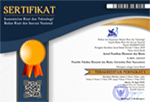INTENTION TO USE MOBILE BANKING APPLICATION: GENDER-BASED
DOI:
https://doi.org/10.33633/jpeb.v5i2.3126Abstract
This research is aimed to examine the gender difference toward intention to use the mobile banking application in Semarang. Data is collected by self - administered questionnaire, and pass over to bank customer which done their financial transaction by Automatic Teller Machine. The Sample used in this research is 50 respondents, consist of 30 male respondents and 20 female respondents who never have a mobile banking application before. The results of this study indicate that there is a gender difference in the intention to use mobile banking applications. On the other side, even it is easy to be used, female customers are not feeling the benefit offered, thus resistant to use mobile banking applications. This result brings another contradiction toward The Technological Acceptance Model. Data is examined by the SPSS application, and Mann – Whitney statistical model.Keywords: Mobile application; bank; gender differenceReferences
Chung, N., and Kwon, S.J. (2009). The Effects of Customers’ Mobile Experience and Technical Support on the Intention to Use Mobile Banking. CyberPsychology &Behavior, 12(5), 539 - 543.
Davis, F.D. (1989). Perceived Usefulness, Perceived Ease of Use, and User Acceptance of Information Technology. MIS Quarterly, 13(3), 318 - 339.
Dong, J.Q., and Zhang, X. (2011). Gender Differences in Adoption of Information Systems: New Findings From China. Computers in Human Behavior, 27(1), 384 - 390.
Faqih, K.M., and Jaradat, M.I.R.M. (2015). Assessing the Moderating Effect of Gender Differences and Individualism-Collectivism at Individual-Level on the Adoption of Mobile Commerce Technology: TAM3 Perspective. Journal of Retailing and Consumer Services, 22, 37 – 52.
Hyde-Clare, N., Ngcongo, M., and Mnisi, J. (2014). A Gender Gap? Uses and Perception of Mobile Phone Banking in South Africa. International Journal of Humanities and Social Science, 4(1), 170 – 178.
Kleijnen, M., Wetzels, M., and de Ruyter, K. (2004). Consumer Acceptance of Wireless Finance. Journal of Financial Services Marketing, 8(3), 206 - 217.
Laforet, S, and Li, X. (2005). Consumer Attitudes towards Online and Mobile Banking in China. International Journal of Bank Marketing, 23(5), 362 - 380.
Laukkanen, T. (2007). Internet vs Mobile Banking: Comparing Sustomer Value Perceptions. Business Process Management Journal, 13(6), 788 – 797.
Luarn, P., Lin, H.H. (2005). Toward an Understanding of the Behavioral Intention to Use Mobile Banking. Computers in Human Behavior, 21(6), 873 – 891.
Pedersen, P., and Ling, R. (2002). Modifying Adoption Research for Mobile Internet Service Adoption: Cross-Disciplinary Interactions. Proceedings. Presented at The 36th Hawaii International Conference on System Sciences, January 6-9, Big Island, HI
Riquelme, H.E., and Rios, R.E. (2010). The Moderating Effect of Gender in the Adoption of Mobile Banking. International Journal of Bank Marketing, 28(5), 328 – 341
Seidel, G. (2009). Challenges but Opportunities for Mobile Banking. Card Technology Today, 2, 5-6.
Sinisalo, J., Salo, J., Karlajuoto, H., Leppaniemi, M. (2007). Mobile Customer Relationship Management: Underlying Issues and Challenges. Business Process Management Journal, 13(6), 771 - 787.
Venkatesh, V., and Davis, F.D. (2000). A Theoretical Extension of the Technology Acceptance Model: Four Longitudinal Field Studies. Management Science, 46(1), 186 – 204.
Wan, W., Luk, C.L., and Chow, C. (2005). Customers’ Adoption of Banking Channels in Hong Kong. The International Journal of Bank Marketing, 23(2), 255 – 263.
Wang, Y.S., and Liao, Y.W. (2007). The Conceptualization and Measurement of M-Commerce User Satisfaction. Computers in Human Behavior, 23(1), 381 - 398.
Wu, J.H, and Wang, S.C. (2005). What Drives Mobile Commerce? An Empirical Evaluation of the Revised Technology Acceptance Model. Information & Management, 42(5), 719 - 729.
Yang, K.C. (2005). Exploring Factors Affecting the Adoption of Mobile Commerce in Singapore. Telematics and Informatics, 22(3), 257 - 277.
Downloads
Published
How to Cite
Issue
Section
License
The copyright of the received article shall be assigned to the journal as the publisher of the journal. The intended copyright includes the right to publish the article in various forms (including reprints). The journal maintains the publishing rights to the published articles.
This work is licensed under a Creative Commons Attribution 4.0 International License.


.png)









